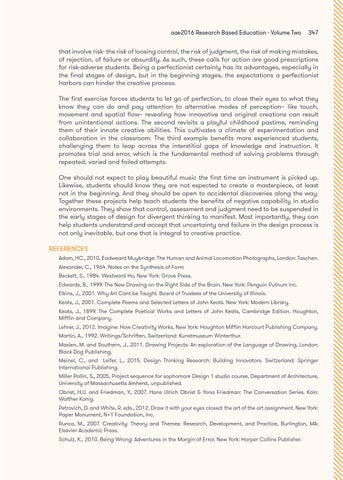aae2016 Research Based Education - Volume Two
347
that involve risk- the risk of loosing control, the risk of judgment, the risk of making mistakes, of rejection, of failure or absurdity. As such, these calls for action are good prescriptions for risk-adverse students. Being a perfectionist certainly has its advantages, especially in the final stages of design, but in the beginning stages, the expectations a perfectionist harbors can hinder the creative process. The first exercise forces students to let go of perfection, to close their eyes to what they know they can do and pay attention to alternative modes of perception– like touch, movement and spatial flow– revealing how innovative and original creations can result from unintentional actions. The second revisits a playful childhood pastime, reminding them of their innate creative abilities. This cultivates a climate of experimentation and collaboration in the classroom. The third example benefits more experienced students, challenging them to leap across the interstitial gaps of knowledge and instruction. It promotes trial and error, which is the fundamental method of solving problems through repeated, varied and failed attempts. One should not expect to play beautiful music the first time an instrument is picked up. Likewise, students should know they are not expected to create a masterpiece, at least not in the beginning. And they should be open to accidental discoveries along the way. Together these projects help teach students the benefits of negative capability in studio environments. They show that control, assessment and judgment need to be suspended in the early stages of design for divergent thinking to manifest. Most importantly, they can help students understand and accept that uncertainty and failure in the design process is not only inevitable, but one that is integral to creative practice. REFERENCES Adam, HC., 2010. Eadweard Muybridge: The Human and Animal Locomotion Photographs, London: Taschen. Alexander, C., 1964. Notes on the Synthesis of Form Beckett, S., 1984. Westward Ho, New York: Grove Press. Edwards, B., 1999. The New Drawing on the Right Side of the Brain. New York: Penguin Putnum Inc. Elkins, J., 2001. Why Art Cant be Taught. Board of Trustees of the University of Illinois. Keats, J., 2001. Complete Poems and Selected Letters of John Keats. New York: Modern Library. Keats, J., 1899. The Complete Poetical Works and Letters of John Keats, Cambridge Edition. Houghton, Mifflin and Company. Lehrer, J., 2012. Imagine: How Creativity Works, New York: Houghton Mifflin Harcourt Publishing Company. Martin, A., 1992. Writings/Schriften, Switzerland: Kunstmuseum Winterthur. Maslen, M. and Southern, J., 2011. Drawing Projects: An exploration of the Language of Drawing, London: Black Dog Publishing. Meinel, C., and Leifer, L., 2015. Design Thinking Research: Building Innovators. Switzerland: Springer International Publishing. Miller Pollin, S., 2005, Project sequence for sophomore Design 1 studio course, Department of Architecture, University of Massachusetts Amherst, unpublished. Obrist, H.U. and Friedman, Y., 2007. Hans Ulrich Obrist & Yona Friedman: The Conversation Series. Koln: Walther Konig. Petrovich, D. and White, R. eds., 2012. Draw it with your eyes closed: the art of the art assignment. New York: Paper Monument, N+1 Foundation, Inc. Runco, M., 2007. Creativity: Theory and Themes: Research, Development, and Practice, Burlington, MA: Elsevier Academic Press. Schulz, K., 2010. Being Wrong: Adventures in the Margin of Error, New York: Harper Collins Publisher.
